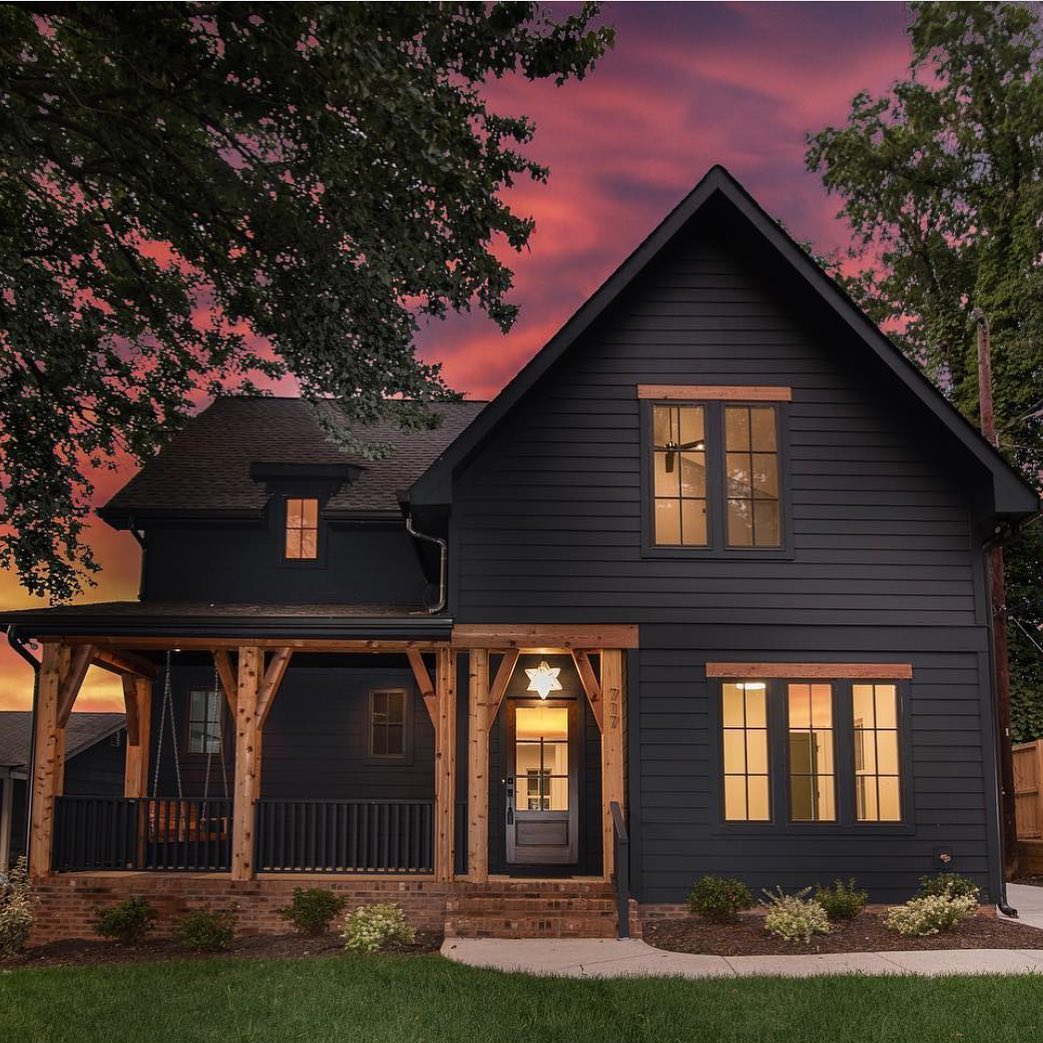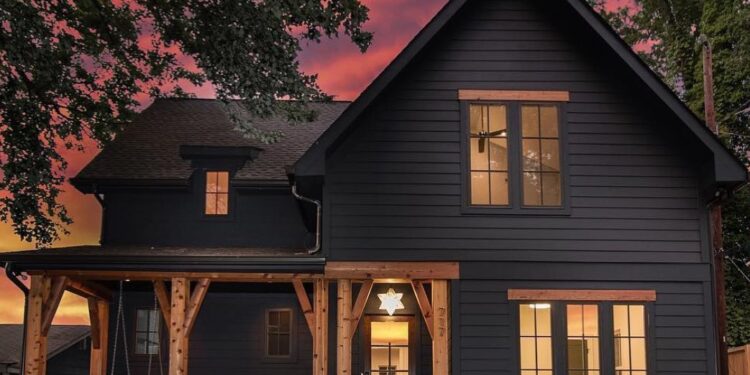As dark house siding takes center stage, this opening passage beckons readers into a world crafted with good knowledge, ensuring a reading experience that is both absorbing and distinctly original. Dark siding materials offer a unique charm and elegance to homes, creating a striking contrast that can elevate the overall aesthetics of any property.
Types of Dark House Siding
Dark house siding can add a touch of elegance and modernity to a home's exterior. There are several types of dark siding materials available, each with its own set of pros and cons. Let's explore some popular options and colors in the market.
Vinyl Siding
Vinyl siding is a cost-effective option that comes in a variety of dark colors such as deep blues, grays, and blacks. It is low maintenance and easy to clean, making it a popular choice for many homeowners. However, vinyl siding may not be as durable as other materials and can fade over time.
Fiber Cement Siding
Fiber cement siding is a durable option that can mimic the look of wood without the maintenance requirements. Dark shades like rich browns and charcoals are available in this material. While fiber cement is resistant to rot and insects, it can be more expensive to install compared to vinyl.
Wood Siding
Wood siding offers a natural and timeless appeal to a home's exterior. Dark stains or paints can be applied to wood siding to create a rich and luxurious look. However, wood siding requires regular maintenance to prevent rot, pests, and weather damage.
Metal Siding
Metal siding, such as steel or aluminum, is a long-lasting and durable option for dark house siding. Popular dark colors like deep greens and grays are available in metal siding materials. While metal siding is resistant to fire and pests, it can be prone to dents and scratches.
Pros and Cons of Dark-Colored Siding
Dark-colored siding can make a bold statement and enhance the curb appeal of a home. However, there are some considerations to keep in mind. Dark colors absorb heat, which can lead to increased energy costs for cooling in warmer climates.
Dark siding may also show dirt and imperfections more easily than lighter colors.
Popular Dark Siding Colors
Some popular dark siding colors in the market include:
- Charcoal Gray
- Navy Blue
- Espresso Brown
- Black
- Forest Green
Consider the architectural style of your home and the surrounding environment when choosing a dark siding color to ensure it complements the overall aesthetic.
Design Trends with Dark House Siding

Dark house siding has become a popular choice in modern architecture, adding a touch of sophistication and elegance to residential properties. Let's explore some current design trends that incorporate dark siding and how it can enhance the overall aesthetic appeal of a home.
Architectural Styles that Complement Dark House Siding
When it comes to architectural styles that complement dark house siding, contemporary and modern designs often come to mind. The clean lines and sleek finishes of these styles provide the perfect backdrop for the bold statement that dark siding makes.
Additionally, industrial and minimalist designs can also benefit from the contrast created by dark siding, adding depth and character to the overall look of the property.
Enhancing Curb Appeal with Dark Siding
Dark house siding can greatly enhance the curb appeal of a home by creating a striking visual impact. When paired with contrasting elements such as light-colored trims or landscaping features, dark siding can create a sense of drama and sophistication.
Additionally, dark siding can help a home stand out in a neighborhood, making it a focal point and increasing its overall value
Maintenance and Care for Dark Siding
Dark house siding requires specific maintenance to keep it looking its best and preserve its color over time. Here are some essential tips to help you care for your dark siding:
Regular Cleaning
- Regularly clean your dark siding with a mixture of mild soap and water to remove dirt, dust, and grime that can accumulate over time.
- Use a soft-bristle brush or a cloth to gently scrub the siding and avoid causing any damage to the surface.
- Rinse the siding thoroughly with clean water to ensure all the soap residue is removed.
Preventing Fading
- Apply a UV-resistant coating or paint specifically designed for dark siding to protect it from sun damage and fading.
- Avoid using harsh chemicals or abrasive cleaners that can strip away the color and finish of the siding.
- Inspect the siding regularly for any signs of wear or damage, and address any issues promptly to prevent further deterioration.
Weathering Effects
- Dark siding is more prone to showing signs of weathering, such as discoloration or chalking, due to exposure to the elements.
- Consider applying a protective sealant or clear coat to the siding to provide an extra layer of defense against weathering.
- Monitor the condition of your dark siding throughout the year and take necessary precautions to maintain its appearance and structural integrity.
Energy Efficiency and Insulation with Dark Siding
Dark house siding can actually provide energy-saving benefits due to its insulating properties. The color of the siding can impact the energy efficiency of a home by affecting how much heat is absorbed or reflected.
Insulation Properties
When comparing dark siding to light-colored siding, dark siding tends to absorb more heat from the sun. This can be beneficial in cooler climates as the extra heat absorbed can help keep the home warmer. However, in warmer climates, this can lead to increased cooling costs as the heat absorbed by the siding can transfer into the home.
Maximizing Energy Efficiency
To maximize energy efficiency with dark house siding, consider the following tips:
- Ensure proper insulation in the walls to prevent heat transfer.
- Use light-colored roofing to reflect sunlight and reduce heat absorption.
- Plant trees or install awnings to provide shade and reduce the amount of heat absorbed by the siding.
- Consider using energy-efficient windows and doors to further enhance insulation.
Final Wrap-Up
In conclusion, dark house siding is not just a practical choice but also a design statement that can transform the look and feel of your home. By understanding the different types, design trends, maintenance needs, and energy efficiency aspects of dark siding, you're equipped to make informed decisions for your property.
Embrace the allure of dark house siding and watch your home stand out in style.
FAQ Explained
Is dark house siding suitable for all types of homes?
Dark house siding can complement various architectural styles, from modern to traditional, adding depth and character to the facade.
How often should I clean dark house siding?
It's recommended to clean dark siding at least once a year to maintain its color and appearance.
Does dark siding increase energy efficiency?
Dark siding can absorb more heat from the sun, which may help in reducing energy costs during colder months.
Are there specific maintenance tips for preserving dark siding color?
Using a mild detergent and a soft brush for cleaning, along with regular inspections for damage, can help preserve the color of dark house siding.


